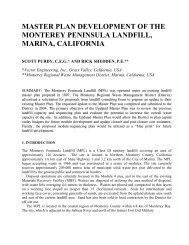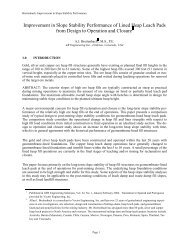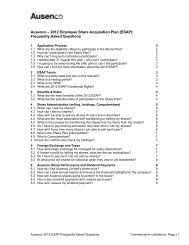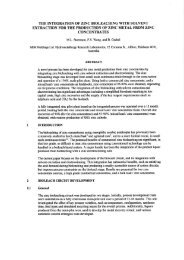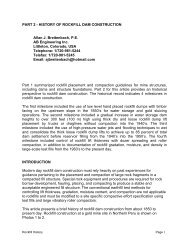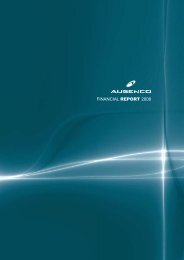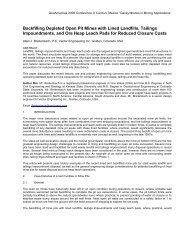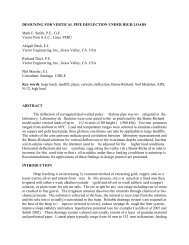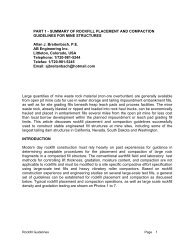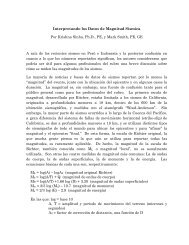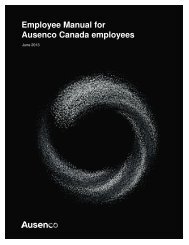SITE SELECTION STUDY FOR A NEW SANITARY ... - Ausenco
SITE SELECTION STUDY FOR A NEW SANITARY ... - Ausenco
SITE SELECTION STUDY FOR A NEW SANITARY ... - Ausenco
You also want an ePaper? Increase the reach of your titles
YUMPU automatically turns print PDFs into web optimized ePapers that Google loves.
event. Next, the 21 hectares of waste fill grades and contributing graded areas were descretized intosub-areas delineating potential run-off flow paths and concentration points. The waste fill gradeswere subsequently divided up into 8 top sub-areas and 17 side-slope areas. The surrounding gradedareas that also contribute to total run-off were divided into 4 sub-areas. Along the anticipated flowpath, run-off concentration points were identified as channel grades and contributing sub-areas wereencountered. A drainage division line was prescribed from the drainage center of the landfill cell,which separates the sub-areas into an east and west drainage route. Finally, a run-off coefficientwas determined based on the character, condition, imperviousness, slope, and pondingcharacteristics of the soil of each sub-area.The key design consideration involving the hydrology and drainage analysis involved divertingstormwater off of the initial waste management cell prior to refuse covering the entire module floor.The first waste management cell will be approximately 5 hectares in size in order to take advantageof economies of scale to obtain the most cost effective installation. A 5 hectare site will result in alarge area of the cell being exposed to precipitation before a layer of refuse can be placed over theentire module. Any precipitation that enters the leachate collection and removal system (LCRS) willrequire treatment and disposal. In order to limit the amount of leachate, the surface area of theLCRS exposed to precipitation was reduced. This was accomplished by constructing a diversionberm through the LCRS within the first landfill development cell. Any stormwater entering theupgradient half of the cell will be diverted out of the LCRS and into a drainage channel outside ofthe cell. After refuse has been placed in the downgradient half of the module, the outlet to thedrainage channel will be closed and the LCRS from the upgradient half of the cell will be connectedto main collection system. This temporary diversion of stormwater will result in a substantialreduction in handling and treatment costs as the cell is developed. A detail of this system includingthe leachate collection system and liner system is shown on Figure 1.3. LEACHATE GENERATION, HANDLING, AND TREATMENT3.1 Leachate Generation AnalysisThe following section provides a discussion of the simulations that were performed to estimate theleachate production for the landfill. The discussion includes descriptions of the computer modelused to perform the analyses, the climatological and soil characteristic input parameters, thesimulations performed, and the results of the analysis.Leachate generation potential was estimated using the Hydrologic Evaluation of LandfillPerformance Model (HELP), version 3.06. The HELP model was first generated in 1983 by theU.S. Army Corps of Engineers (USCOE) under contract with the USEPA. Documentation of theoriginal version of the help computer program can be found in USEPA report 530 SW-84-010, datedJune 1984 and the engineering documentation for version 3 was prepared by Schroeder (1994). TheHELP computer program is a water balance model that uses climatological data and soilcharacteristics to predict the infiltration of precipitation that falls within the landfill boundaries. TheHELP model, using a daily climatological data base to calculate run-off, infiltration, andevapotranspiration, models the effects of hydrologic processes, including precipitation, surfacestorage, run-off, infiltration, percolation, evapotranspiration, soil and waste moisture storage, andlateral drainage. The model simulates the effects of hydrologic processes on the water balance for alandfill by performing daily sequential analyses using a quasi-two-dimensional, deterministicapproach. Water is apportioned to the different hydrologic pathways depending upon the



